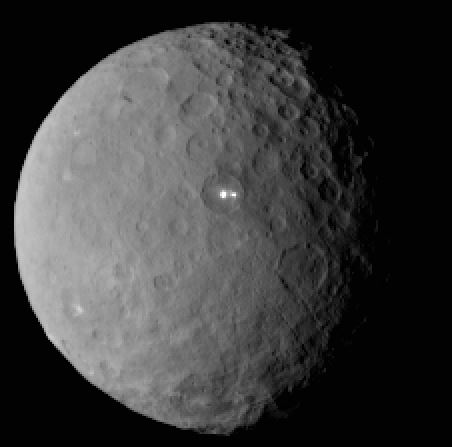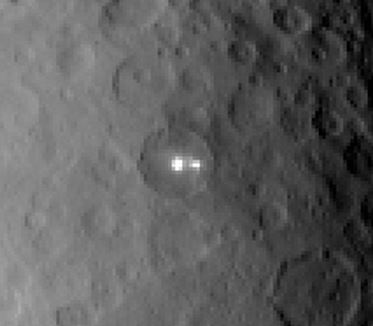A photograph from NASA’s Dawn spacecraft shows two mysterious bright objects on the surface of the dwarf planet Ceres. Scientists were puzzled when only one bright object was seen, but as the spacecraft got nearer and another one was observed next to it, their bewilderment increased.
In the image, taken almost 29,000 miles (46,000 kilometers) from Ceres, a companion bright spot appeared in the same basin.
Principal investigator for the Dawn mission, based at the University of California, Los Angeles, Chris Russell, said:
“Ceres’ bright spot can now be seen to have a companion of lesser brightness, but apparently in the same basin.”
“This may be pointing to a volcano-like origin of the spots, but we will have to wait for better resolution before we can make such geologic interpretations.”

Image taken by NASA’s Dawn spacecraft 29,000 miles from the dwarf planet Ceres shows two bright objects in the same basin. (Image: http://dawn.jpl.nasa.gov/)
Dawn, which uses its own ion propulsion system, is expected to orbit around Ceres on March 6th, 2015. As the spacecraft gets closer and captures more detailed images of the dwarf planet during the next 16 months, scientists hope to grain a better understanding of its origin and evolution.
They say the fascinating bright spots and other features of interest will come into sharper focus.
Lead investigator for the framing camera team at the Max Planck Institute for Solar System Research, Gottingen, Germany, Andreas Nathues, said:
“The brightest spot continues to be too small to resolve with our camera, but despite its size it is brighter than anything else on Ceres. This is truly unexpected and still a mystery to us.”

Theories among alien-life enthusiasts are rife on the Internet, with some people wondering whether the lights might come from an advanced civilization.
Dawn flew close to Vesta, the giant asteroid, from 2011 to 2012, and delivered over 30,000 photographs of the body as well as other data. Scientists said it provided insights into the asteroid’s composition and geological history.
Ceres and Vesta, with diameters of 590 miles (950 km) and 326 miles (525 km) respectively, are the two largest bodies in the asteroid belt, located between Jupiter and Mars.
